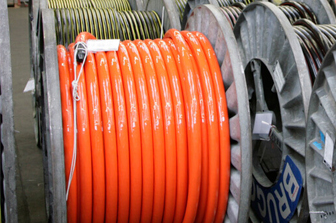The Difference Between Electrical Power Cable and Control Cable
Ⅰ. The role of electrical power cables and control cables
You may often hear electrical power cables and control cables mentioned in engineering projects, but do you know the respective functions of electrical power cables and control cables? Control cables directly transmit electrical energy from the power distribution point of the power system to the power connection lines of various electrical equipment, while electrical power cables are mainly used for the transmission of strong electrical energy in the generation, distribution, transmission, transformation, and power supply lines, and the current passing through is large. The electrical power cable is used in the main line of the power system to transmit and distribute large-function electrical energy.
Ⅱ. The difference between power cables and control cables
1. Executive standard:
Control cable is 9330, electrical power cable is GB12706.
2. Core color:
The color of the insulated core of the control cable is usually black with white lettering, and the low voltage of the electrical power cable is generally color-separated.
3. Cross section:
The electrical power cable is a one-time load wire. The current carrying capacity increases with the increase of power. The application cross section of the wire must also increase with the increase of current. Therefore, the size of the power cable is generally larger, up to 500 square meters. , No matter how large the cross-section is, there are generally fewer chinese cable manufacturers that can do it. The control cable is a secondary command wire used to control the current-carrying operation of the contactor and other equipment. The load current is very small and the wire section is very small. Therefore, the section of the control cable is usually small, and the maximum is usually no more than 10 square.
4. Cable core number:
The number of cores of the power cable is relatively small, including single core, two cores, 3 cores, 4 cores and 5 cores. According to the requirements of the power grid, the maximum is generally 5 cores. Control cables are used to transmit control signals, which contain a large number of cores, ranging from 2 cores to 61 cores or more. Control cables also use various core wire structures and shielding measures to obtain satisfactory electromagnetic compatibility effects.
5. Rated voltage:
The rated voltage of the power cable is generally 0.6/1kV and above, and the control cable is mainly 450/750V.
6. Wire sheath:
The power cable requires the wire sheath to have sufficient compressive strength, tensile strength, temperature resistance and corrosion resistance. The control cable requirements are relatively low. When producing industrial power cables and control cables of the same specification, the thickness of the insulation and sheath of the electrical power cable is thicker than that of the control cable.
 English
English  français
français  Deutsch
Deutsch  العربية
العربية  tiếng việt
tiếng việt  ไทย
ไทย  čeština
čeština  Indonesia
Indonesia  Eesti
Eesti  български
български  slovenčina
slovenčina 



